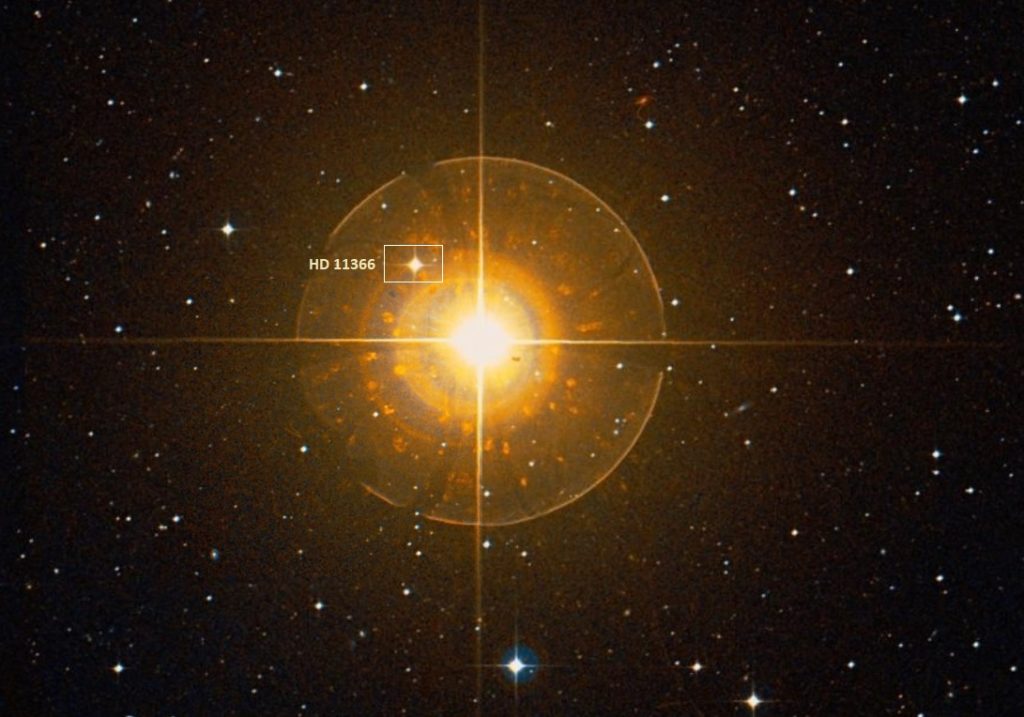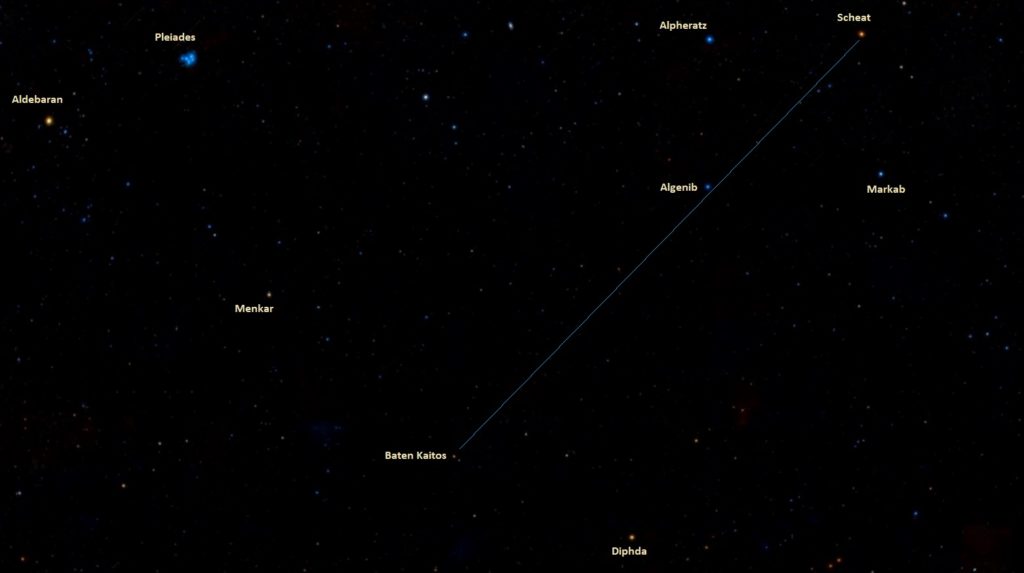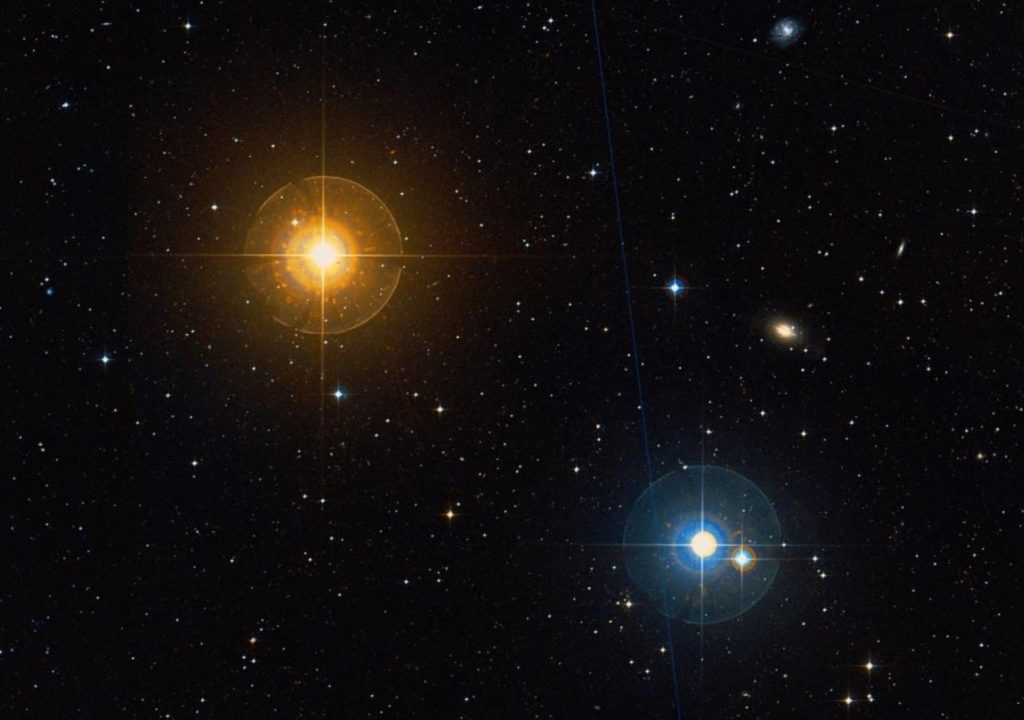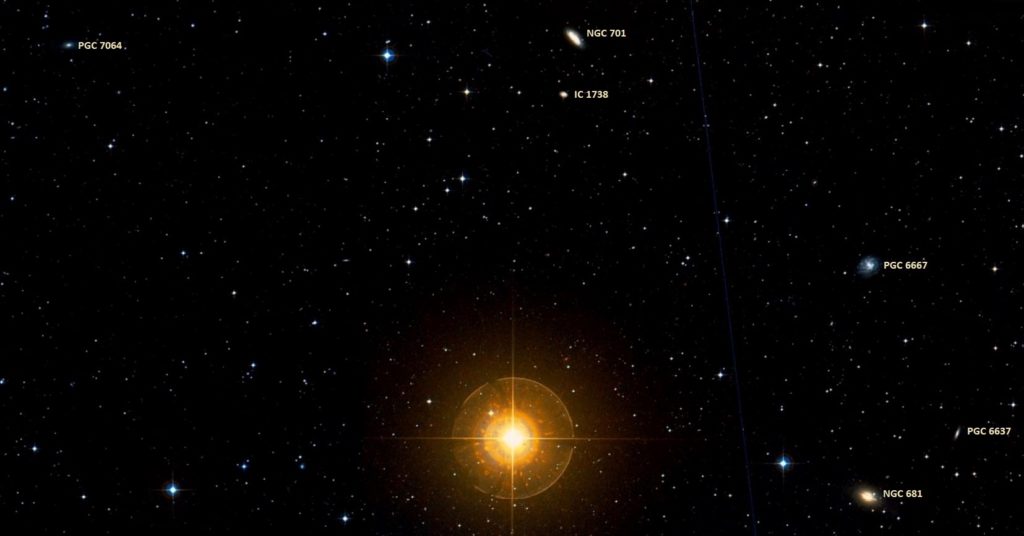Baten Kaitos, Zeta Ceti (ζ Cet), is a double star located in the constellation Cetus. It marks the belly of Cetus, the mythical sea monster associated with the myth of Perseus. With an apparent magnitude of 3.742, it is usually the eighth brightest star in Cetus (when it is not outshone by the variable Mira). It lies at an approximate distance of 235 light years from Earth.
Star system
Zeta Ceti is a binary star system consisting of an orange giant star of the spectral type K0 III Ba0.1 (some sources give the spectral class K0.5 III) and a companion that cannot be resolved in telescopes. The suffix “Ba0.1” indicates that the primary component is a weak barium star. Barium stars are not uncommon in binary systems. The overabundance of barium is believed to be the result of mass transfer that occurred when the giant star was still on the main sequence and the secondary component was a carbon star on the asymptotic giant branch (AGB).
The Zeta Ceti system is a single-lined spectroscopic binary, which means that only the giant star is seen and the existence of the companion is inferred by the primary component’s spectral lines shifting towards the blue, then towards red, and then blue again, indicating that the star is moving toward and away from us, i.e. orbiting around an unseen centre of mass. The stars in the Zeta Ceti system orbit each other with a period of 4.5 years and an eccentricity of 0.59.
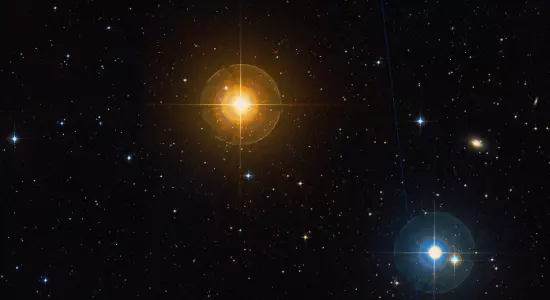
Baten Kaitos (Zeta Ceti), image: Wikisky
The primary star has a mass 2.34 times that of the Sun and, having exhausted the supply of hydrogen to burn in its core, it has expanded to a radius 25 times solar. With a surface temperature of 4,581 K, it shines with 240 solar luminosities. The star is a relatively slow spinner, with a projected rotational velocity of 3.2 km/s. Its estimated age is about 1.24 billion years.
The system is catalogued as WDS J01515-1020A in the Washington Double Star Catalog and the two components are designated WDS J01515-1020 Aa and Ab. There is another star listed as a companion, designated WDS J01515-1020B, but it is only a line-of-sight companion and not physically related to the Zeta Ceti system. The star is an orange giant (K0 III) located much further away (1,366 light years). It has the designation HD 11366 in the Henry Draper Catalogue (HD).
Facts
In Arabic astronomy, Baten Kaitos was part of an asterism known as “the Hen Ostriches” (Al Naʽāmāt). The 17th century Egyptian astronomer Al Achsasi al Mouakket called the star Rabah al Naamat, meaning “the fourth ostrich.” The name was translated into Latin as Quarta Struthionum. The other stars that formed the asterism were Eta Ceti (Prima Struthionum), Theta Ceti (Secunda Struthionum), and Tau Ceti (Tertia Struthionum). Al Mouakket designated Almach in Andromeda as Quinta Struthionum, but the name was more commonly associated with Upsilon Ceti.
Name
The name Baten Kaitos (pronunciation: /ˈbeɪtən ˈkeɪtɒs/) comes from the Arabic phrase batn qaytus, meaning “the belly of the sea monster.” It refers to the star’s position in the constellation Cetus.
The name was officially approved by the International Astronomical Union’s (IAU) Working Group on Star Names (WGSN) on September 12, 2016. It formally applies only to the component Zeta Ceti Aa but has traditionally been used for the whole system.
The Chinese know Baten Kaitos as 天倉四 (Tiān Cāng sì), the Second Star of Square Celestial Granary. Square Celestial Granary is a Chinese asterism formed by Zeta Ceti with Iota Ceti, Eta Ceti, Theta Ceti, Tau Ceti, and 57 Ceti. The asterism is part of the Bond mansion, which represents the body of the White Tiger.
Location
Baten Kaitos marks the belly of Cetus and is located in the area between the brighter Diphda in the sea monster’s tail and Menkar in its head. It can be found using the bright stars that form the Great Square of Pegasus: Alpheratz, Scheat, Markab, and Algenib. A line drawn from Scheat through Algenib points in the direction of Zeta Ceti.
The star Chi Ceti lies in the same field of view as Baten Kaitos and can be seen without binoculars under good viewing conditions. It is a double star consisting of the brighter component HD 11171 (mag. 4.66) and the fainter HD 11131 (6.75). The stars share a similar proper motion and are believed to be physical companions. The Chi Ceti system is considerably closer to us than Zeta Ceti. It lies at a distance of 75.6 light years.
Baten Kaitos can be used to find several relatively bright galaxies that lie in the vicinity of the star. These include the spiral galaxies NGC 701, IC 1738, NGC 681 (the Little Sombrero Galaxy), PGC 6637, and PGC 6667, which form the NGC 681 Group.
Constellation
Baten Kaitos is located in the constellation Cetus, the Whale. Cetus is one of the 48 Greek constellations, first listed by the astronomer Ptolemy of Alexandria in the 2nd century CE. Occupying an area of 1,231 square degrees, it is the fourth largest constellation in the sky, after Hydra, Virgo, and Ursa Major. Even though it is large, Cetus is not particularly conspicuous, with only two stars brighter than magnitude 3.00: the constellation’s luminary Diphda (Beta Ceti) and the slightly fainter Menkar (Alpha Ceti).
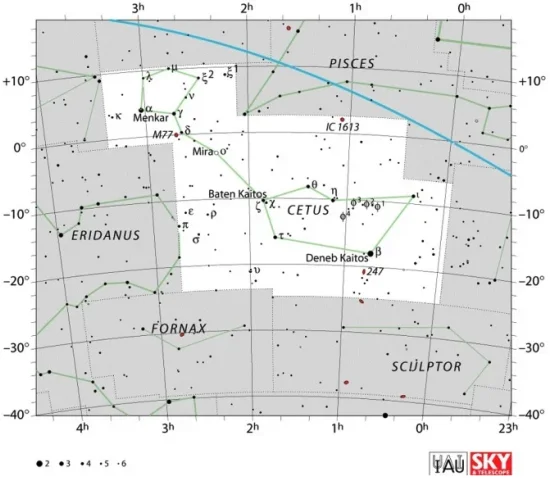
Cetus constellation map by IAU and Sky&Telescope magazine
Cetus is known for its variable stars Mira (Omicron Ceti), a pulsating red giant, and UV Ceti, a flare star and one of the nearest star systems to the Sun, as well as for Tau Ceti, one of the nearest solar twins (G-type main sequence stars) to Earth, which hosts five candidate planets. The constellation is also home to the most distant star discovered as of March 2022. Earendel (WHL0137-LS) has a comoving distance of 28 billion light-years.
Other than the galaxies NGC 701, IC 1738, and NGC 681, bright deep sky objects in Cetus include the barred spiral galaxy Messier 77, also known as Cetus A, the magnitude 8 planetary nebula NGC 246, also known as the Cetus Ring or Skull Nebula, the spiral galaxies NGC 247, NGC 1042, NGC 1035, and NGC 1055, and the irregular dwarf galaxy IC 1613.
The best time of year to observe the stars and deep sky objects in Cetus is during the month of November.
The 10 brightest stars in the constellation are Diphda (Beta Ceti, mag. 2.02), Menkar (Alpha Ceti, mag. 2.53), Eta Ceti (mag. 3.446), Kaffaljidhma (Gamma Ceti, mag. 3.47), Tau Ceti (mag. 3.50), Iota Ceti (mag. 3.562), Theta Ceti (mag. 3.60), Baten Kaitos (Zeta Ceti, mag. 3.742), Upsilon Ceti (mag. 3.95), and Delta Ceti (mag. 4.06). The pulsating variable star Mira (Omicron Ceti, mag. 2.0 – 10.1) is sometimes among the brightest stars in the constellation and at other times it is invisible to the unaided eye.
Baten Kaitos – Zeta Ceti
| Spectral class | K0 III Ba0.1 or K0.5III |
| Variable type | Suspected |
| U-B colour index | +1.076 |
| B-V colour index | +1.131 |
| Apparent magnitude | 3.742 |
| Absolute magnitude | -0.54 |
| Distance | 235 ± 10 light years (72 ± 3 parsecs) |
| Parallax | 14.7225 ± 0.4128 mas |
| Radial velocity | +10.86 ± 0.64 km/s |
| Proper motion | RA: +40.80 mas/yr |
| Dec.: −37.25 mas/yr | |
| Mass (Zeta Ceti A) | 2.34 M☉ |
| Luminosity (Zeta Ceti A) | 240 L☉ |
| Radius (Zeta Ceti A) | 25 R☉ |
| Temperature (Zeta Ceti A) | 4,581±14 K |
| Metallicity (Zeta Ceti A) | -0.13 dex |
| Age (Zeta Ceti A) | 1.24 billion years |
| Rotational velocity (Zeta Ceti A) | 3.2 km/s |
| Surface gravity (Zeta Ceti A) | 2.4 cgs |
| Constellation | Cetus |
| Right ascension | 01h 51m 27.63482s |
| Declination | −10° 20′ 06.1289″ |
| Names and designations | Baten Kaitos, Zeta Ceti, ζ Cet, 55 Ceti, HD 11353, HR 539, HIP 8645, BD−11° 359, SAO 148059, PPM 210734, FK5 62, GC 2249, GCRV 1038, WDS J01515-1020A, WDS J01515-1020Aa,Ab, CCDM J01515-1019A, CSV 100139, IDS 01465-1049 A, IRAS 01489-1034, 2MASS J01512762-1020061, NSV 638, TYC 5278-2437-1, Gaia DR2 2461150714559889920 |
